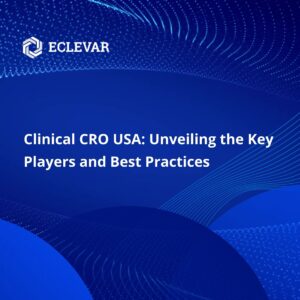What are the key players and best practices in the clinical CRO in the USA?
FDA’s Center for Devices and Radiological Health (CDRH) is responsible for regulating firms who manufacture, repackage, relabel, and/or import medical devices sold in the United States.
The landscape for FDA’s medical device approval can be though for manufacturers to travel alone, so working alongside a responsible and experienced Contract Research Organization is most important.
Get to know more about the FDA’s system for marketplacing and an experienced CRO in USA for successful trials and efficient research.
Why work with a Clinical CRO in USA market?
Contract Research Organization (CRO) solutions have emerged as a means to simplify and streamline the clinical trial process within the medtech market. By outsourcing the work to specialized teams with the necessary expertise and experience, companies can benefit from well-structured, safe, and efficient studies while reducing costs.
CRO’s landscape ranges from large, international full-service organizations to smaller, niche specialty groups. Selecting the right CRO for research support entails finding a company that possesses the most relevant experience in the targeted field of study.
The right CRO is equipped to provide comprehensive documentation assistance and ensure the security and efficacy of medical products. They follow the rigorous guidelines set forth by regulatory bodies like the FDA, ensuring compliance and adherence to the established standards. By partnering with a quality CRO, medical device developers can enhance the credibility and trustworthiness of their products.
FDA’s Establishment Registration
In order to comply with FDA regulations, both domestic and foreign manufacturers, as well as initial distributors or importers of medical devices, are required to register their establishments. This registration process must be completed electronically unless the FDA grants a waiver.
It is mandatory for all registered establishments to verify their registration information on an annual basis, specifically between October 1st and December 31st of each year. Foreign manufacturers have an additional requirement of designating a U.S. Agent to represent them.
Since October 1, 2007, most establishments are also subject to paying an establishment registration fee. These measures ensure transparency, accountability, and regulatory oversight within the medical device industry to protect public health and safety.
Medical Device Listing
Manufacturers must include the following information when listing their devices with the FDA:
- Name of the manufacturers
- Manufacturers’ contact
- Sterilizers’ contract
- Repackagers and relabelers information
- Specification developers
- Reprocessors single-use devices
- Remanufacturers (if applies)
- Manufacturers of any accessories and components sold directly to the end user
- U.S. manufacturers of “export only” devices
Premarket Notification 510(k)
If you intend to commercially distribute a medical device that requires a Premarket Notification 510(k), you must obtain a letter of substantial equivalence from the FDA before doing so. This letter authorizes the distribution of the device and confirms that it is comparable to a legally marketed device in the United States.
The FDA considers devices that were on the market before May 28, 1976, or those that have been determined to be substantially equivalent, as suitable references for demonstrating substantial equivalence in the 510(k) submission.
The Medical Device User Fee and Modernization Act of 2002, enacted on October 26, 2002, grants the FDA the authority to impose fees for the review of Premarket Notification 510(k) submissions. These fees are applicable to Traditional, Abbreviated, and Special 510(k)s.
Classification of devices
Certain medical devices, primarily those classified as Class I devices and some Class II devices, are exempt from the requirement of submitting a Premarket Notification 510(k). These exemptions are based on the level of risk associated with the device and the FDA’s determination that a 510(k) submission is unnecessary for ensuring its safety and effectiveness.
If you are planning to submit a 510(k) application to the FDA for a Class I or Class II device, seeking a 510(k) review by an expert may be advantageous.
Premarket Approval (PMA)
products requiring Pre-Market Approvals (PMAs) are categorized as Class III devices, which are considered high-risk devices posing a significant threat of illness or injury. Such devices may also include those that are not deemed substantially equivalent to Class I and II predicate devices through the 510(k) process.
In contrast to other regulatory pathways, the PMA process is more rigorous and entails the submission of clinical data to substantiate the claims made for the device. This extensive evaluation ensures that these high-risk devices undergo thorough scrutiny to minimize potential risks to public health and safety.
starting from the fiscal year 2003, medical device user fees have been implemented for original PMAs and specific types of PMA supplements. However, there are provisions to support small businesses, as they may be eligible for reduced or waived fees. This consideration aims to facilitate innovation and market entry for smaller companies that may face financial constraints, encouraging them to participate in the regulatory process and contribute to the development of safe and effective medical devices while balancing the need for adequate oversight and patient protection.
Investigational Device Exemption (IDE)
An IDE allows an investigational device to be used in a clinical study, facilitating the collection of safety and effectiveness data necessary to support a Premarket Approval (PMA) application or a Premarket Notification 510(k) submission to the FDA. For clinical studies involving devices of significant risk, approval from both the FDA and an Institutional Review Board (IRB) is mandatory before the study can commence. This dual approval process ensures that rigorous ethical and safety standards are upheld during the research. On the other hand, studies involving devices of nonsignificant risk only require approval from the IRB, streamlining the regulatory process while maintaining a focus on patient welfare and ethical considerations.
Quality System Regulation (QS regulation)
This regulation encompasses different aspects such as: the methods employed, facilities utilized, and controls implemented throughout the entire lifecycle of medical devices. These include:
- Designing
- Purchasing
- Manufacturing
- Packaging
- Labelling
- Storing
- Installing
- Servicing
To ensure compliance with these requirements, manufacturing facilities undergo inspections conducted by the FDA.
These inspections serve as means to verify and assure that the facilities adhere to the QS requirements, emphasizing the importance of maintaining high standards in the manufacturing processes and overall quality management of medical devices.
Labelling
Labelling regards not only the labels directly affixed to the device but also the descriptive and informational literature that accompanies it. According to Section 201(k), a ‘label’ is defined as any written, printed, or graphic matter displayed on the immediate container of the device. However, this definition excludes package liners.
Any information present on the immediate container should also be visible on the outside container or wrapper, or if applicable, it should be easily legible through the outside packaging.
This regulatory framework ensures that the necessary information and instructions regarding the medical device are clearly communicated to users and healthcare professionals. Proper labelling is crucial for ensuring the safe and effective use of medical devices and providing users with the relevant information they need to make informed decisions.
By defining ‘label’ and ‘labelling’ in specific terms, the regulations ensure that manufacturers comply with the requirement of providing comprehensive and accurate information on the device and its packaging, thus promoting transparency and safety in the medical device industry.
Medical Device Reporting
The Medical Device Reporting (MDR) program requires incidents involving a medical device that may have resulted in death or serious injury to be reported to the FDA. Certain malfunctions of devices are also subject to reporting.
This regulation serves as a vital mechanism for both the FDA and manufacturers to identify and monitor significant adverse events associated with medical devices. The overarching goals of this regulation are to detect and rectify issues promptly, ensuring that any problems or risks associated with medical devices are addressed in a timely manner.
By implementing the program, the FDA and manufacturers can collaborate to enhance patient safety by monitoring adverse events and taking appropriate corrective actions to mitigate potential risks posed by medical devices.
Eclevar – trust us as your Clinical CRO in USA
Our team of professionals is dedicated and competent, with experience in not only navigating the USA framework for medical device’s regulation, but also other jurisdictions. Trust us with your documentation and research management needs, benefit from our more than 20 years of experience in the field, contact us to be your CRO in USA.

